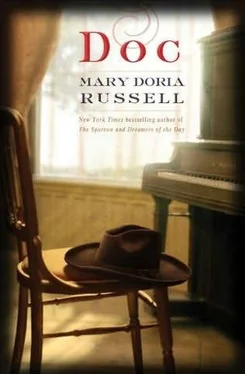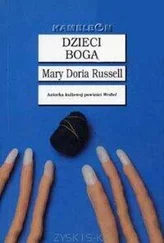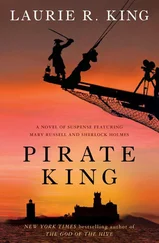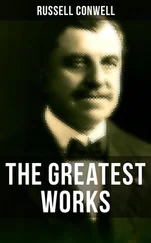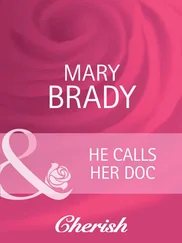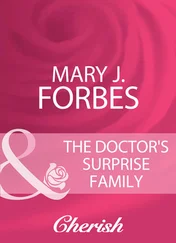Doc
A novel by Mary Doria Russell
For Art Nolan, who told me what Wyatt knew; for Eddie Nolan, who showed us what John Henry had to learn; for Alice McKey Holliday, who raised a fine young man; with thanks to Bob Price and Gretchen Batton.
This book is fiction, but there is always a chance that such a work of fiction may throw some light on what has been written as fact.
—E. HEMINGWAY, A MOVEABLE FEAST
Fictional characters are listed in italics.
The Hollidays
John Henry Holliday, D.D.S., later known as Doc Holliday
Alice McKey Holliday: his mother
Henry Holliday: his father
Wilson and Chainey: brothers, born into his family’s possession
John Stiles Holliday, M.D.: JHH’s uncle
Permelia: his wife
Robert: his younger son, later a dentist
George: his older son; sent to care for JHH in Texas in 1877
Sophie Walton: his foster child; taught JHH to play cards
Martha Anne Holliday: JHH’s childhood sweetheart
Henry Kahn: a bad-tempered gambler; shot JHH in 1877
Mary Katharine “Kate” Harony: a prostitute; JHH’s companion
David W. “Dirty Dave” Rudabaugh: a train robber
George Hoyt: an inexpert assassin
Tobias Driskill: a Texan with a grudge
Billy Driskill: his son, arrested for assault in Dodge
The Earps
Morgan Earp: a policeman; JHH’s closest friend
Louisa “Lou” Houston: his girlfriend
James Earp: Morgan’s brother, a brothel manager
Bessie Bartlett Earp: his wife, the madam
Wyatt Earp: brother of Morgan and James; a policeman
Urilla Sutherland Earp: Wyatt’s wife, deceased
Mattie Blaylock: a Dodge City streetwalker
Lawmen
Lawrence “Fat Larry” Deger: the Dodge City marshal (chief of police)
Ed Masterson: chief deputy to Marshal Deger; deceased
Marshal Deger’s deputies:
Morgan Earp
Wyatt Earp
Jack Brown
Chuck Trask
John Stauber
William Barkley “Bat” Masterson: sheriff of Ford County; half owner, Lone Star Saloon and Dance Hall
Dodge City Chamber of Commerce
Robert C. “Bob” Wright: proprietor, Wright’s General Outfitting Store; member, Kansas House of Representatives
Isabelle “Belle” Wright: his daughter
Alice Wright: his wife
Hamilton “Ham” Bell: proprietor, Hamilton Bell’s Famous Elephant Barn
Chalkley “Chalkie” Beeson: proprietor, the Long Branch Saloon
George “Deacon” Cox: proprietor, the Dodge House Hotel
James H. “Dog” Kelley: mayor of Dodge; proprietor, the Alhambra Saloon
George “Big George” Hoover: proprietor, Hoover’s Cigar Shop and Wholesale Liquors; leader, Dodge City anti-saloon reform movement
Margaret: his wife; formerly the prostitute Maggie Carnahan
Other Kansas Figures (Dodge and Elsewhere)
Edwin “Eddie Foy” Fitzgerald: vaudeville comedian
Verelda: his girlfriend, a prostitute
Jau “China Joe” Dong-Sing: proprietor, China Joe’s Laundry and Baths John Horse Sanders: a young faro dealer
Charles Sanders: Johnnie’s father, deceased; a black man killed in Wichita after defending his wife from two Texans
Father Alexander von Angensperg, S.J.: an Austrian Jesuit; Johnnie Sanders’ favorite teacher at the St. Francis Mission School for Indians, near Wichita
Father John Schoenmakers, S.J.: a Dutch Jesuit; superior of St. Francis
Brother Sheehan, S.J.: an Irish lay brother; taught farming at St. Francis
Father Paul Maria Ponziglione, S.J.: an Italian Jesuit, missionary to the Plains Indians
Captain Elijah Garrett Grier, U.S. Army: stationed at Fort Dodge, Kansas; owner of Roxana
John Riney: tollgate operator , Dodge City toll bridge
Mabel: his wife
John Jr., called “Junior”: his eldest son
Wilfred Eberhardt: a German orphan
Thomas McCarty, M.D.: a Dodge City physician and pharmacist
Nick Klaine: editor, Dodge City Times
D. M. Frost: editor, Ford County Globe
The Animals
Dick Naylor: Wyatt Earp’s horse
Roxana: an Arabian mare owned by Elijah Garrett Grier
Michigan Jim: a quarterhorse owned by Mayor Dog Kelley
Alphonsus: the Jesuits’ mule
He began to die when he was twenty-one, but tuberculosis is slow and sly and subtle. The disease took fifteen years to hollow out his lungs so completely they could no longer keep him alive. In all that time, he was allowed a single season of something like happiness.
When he arrived in Dodge City in 1878, Dr. John Henry Holliday was a frail twenty-six-year-old dentist who wanted nothing grander than to practice his profession in a prosperous Kansas cow town. Hope—cruelest of the evils that escaped Pandora’s box—smiled on him gently all that summer. While he lived in Dodge, the quiet life he yearned for seemed to lie within his grasp.
At thirty, he would be famous for his part in the gunfight at the O.K. Corral in Tombstone, Arizona. A year later, he would become infamous when he rode at Wyatt Earp’s side to avenge the murder of Wyatt’s younger brother Morgan. To sell newspapers, the journalists of his day embellished slim fact with fat rumor and rank fiction; it was they who invented the iconic frontier gambler and gunman Doc Holliday . (Thin. Mustachioed. A cold and casual killer. Doomed, and always dressed in black, as though for his own funeral.) That unwanted notoriety added misery to John Henry Holliday’s final year, when illness and exile had made of him a lonely and destitute alcoholic, dying by awful inches and living off charity in a Colorado hotel.
The wonder is how long and how well he fought his destiny. He was meant to die at birth. The Fates pursued him from the day he first drew breath, howling for his delayed demise.
His mother’s name was Alice Jane.
She was one of the South Carolina McKeys, the third of eleven children. Fair-haired, gray-eyed, with a gentle manner, she came late to marriage, almost twenty at her wedding. Alice was pretty enough and played piano well, but she was educated in excess of a lady’s requirements. She was also possessed of a quiet, stubborn strength of character that had discouraged beaux less determined than Henry Holliday, a Georgia planter ten years her senior.
Alice and Henry buried their firstborn, a sweet little girl who lived just long enough to gaze and smile and laugh, and break her parents’ hearts. Still in mourning for her daughter, Alice took no chances when she was brought to bed with her second child. This time, she insisted, she would be attended by Henry’s brother, a respected physician with modern ideas, who rode to Griffin from nearby Fayetteville as soon as he received her summons.
Labor in Georgia’s wet mid-August heat was grueling. When at last Alice was delivered of a son, the entire household fell quiet with relief. Just moments later, a dreadful cry went up once more, for cleft palates and cleft lips are shocking malformations. The newborn’s parents were in despair. Another small grave in the red north Georgia clay. But Dr. John Stiles Holliday was strangely calm.
“This need not be fatal,” the physician mused aloud, examining his tiny nephew. “If you can keep him alive for a month or two, Alice, I believe the defects can be repaired.”
Читать дальше
